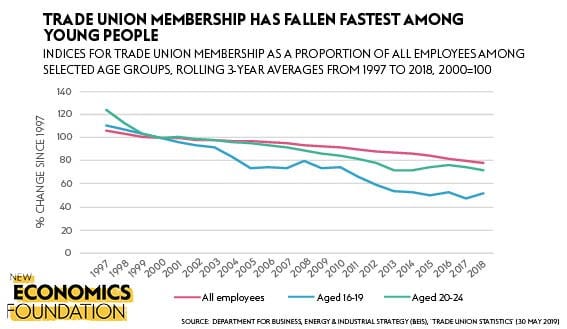Youth membership of unions grows amidst decades of decline
Despite the recent uptick, the proportion of 16-19 year olds who are members of a union has halved since 1995
30 May 2019
As part of a wider increase in the absolute number of employees who are union members, membership for 16 – 19 year old workers increased to 3.2% in 2018 (up from 2% in 2017). But despite this recent uptick the percentage of employed 16 – 19 year olds in unions dropped by more than a half in the decade between 2008 and 2017, from 4.4% to 2%, meaning it is at half of the level it was in 1995 when it was 6.4%, according to New Economics Foundation (NEF) responding to today’s figures from BEIS.
Meanwhile membership for workers under 24 has risen from 7.8% to 8.4% this year bucking the trend of decline as membership for 20 – 24 year old workers almost halved between 1995 and 2018, dropping from 19.3% to 10.5%.
Today less than 1 in 10 workers under the age of 24 are in a union. The decline in the membership of young workers is starker than the overall trend of union decline over the last 20 years.
Meanwhile there have been approximately 10,000 young people on the streets for the school climate strikes in recent months, which shows that young people are not apathetic and are willing to take collective action over issues that matter to them. By way of illustration of the current low union representation among young people, if all of the 10,000 climate strikers were to join a union when they come of age it would increase the number of members for 16 – 19-years olds by approximately one third beginning to reverse the long-term decline among this age group.
Unions are alert to the need to appeal to and represent young people. The higher education union UCU are the first trade union to have pledged support for the school students’ general strike for climate planned on September 27th. Last year the GMB union struck a deal with the University of East Anglia to offer free union membership to all working students.
In the US where a similar long-term trend of union decline exists, there was surge in membership among young people in 2017: out of 858,000 net new jobs for workers under age 35, almost one in four (23%) was unionised.
Frances Fox, 18 and Abel Harvie-Clark, 17, UK Student Climate Network said: “The youth strikes show a radical consciousness amongst our generation and a recognition of the power of collective action to bring change. We strongly encourage other young people to join unions, to continue this collective action as part of the labour movement, to fight for both climate and social justice. To voice the concerns of the youth, whilst listening to the concerns of the workers.
“As it stands, our generation has no future. We, the next generation of workers, will face not only an increasingly insecure job market, zero hour contracts and falling living standards, but also the destructive impacts of the climate crisis. Whilst the anti-trade union laws are awful and an explicit repression of the right to protest, the labour movement has the strength to bring about the radical changes that we need.”
Alice Martin, Head of Work and Pay at the New Economics Foundation said:
“While the growth in youth membership is a reason for optimism, the long-term trend of the decline among young workers is still of concern. Without a pipeline of new members into trade unions, as a society we are less able to democratically shape the world of work – which is set to change dramatically over the coming decades in response to climate change climate change and accelerating automation.
“The school climate strikers are a growing group of young people who have chosen to take action in the face of a crisis and are prepared to strike – these are exactly the kinds of young people that should be attracted to the union movement and could be critical to making up the next generation of trade unionists in this country.”
Notes to editors
For more on NEF’s work on work and pay see: https://neweconomics.org/search/issue/work
The New Economics Foundation is a charitable think tank. We are wholly independent of political parties and committed to being transparent about how we are funded.

1. Membership figures (percentage of all employees in a given age group) as reported by BEIS — to account for survey data volatility, the data is presented as a 3‑year rolling average (for each year, the average of value for that year and the two preceding years).
2. In the chart, the 3‑year averages have been re-scaled to index year 2000 = 100 for all age groups presented.
The overall figures show an increase in absolute number of employees across all age groups who are union members, from 6,247,000 to 6,350,000. And increase of 0.1%, from 23.3% to 23.4%.
For more on BEIS trade union statistics: https://www.gov.uk/government/statistics/trade-union-statistics-2018
For more on the US long-term trends in union membership: https://www.epi.org/publication/biggest-gains-in-union-membership-in-2017-were-for-younger-workers/
Image: Neil Schofield (CC BY-NC-ND 2.0)






